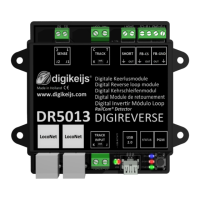DR5013 DIGIREVERSE
P 29
www.digikeijs.com
® R-Bus, B-Bus are trademarks which are registered in the name of Modelleisenbahn GmbH. XpressNet and RS-Bus is a trademark registered in the name of Lenz
Stand 2021-07-06
5.5 DR5013 connecon with sensor tracks (S1,S2) without LocoNet®
This connecon example shows the use of the DR5013 in conjuncon with sensor tracks (S1,S2). The occupied signal of the KS is transmied via an external feedback unit, in this case a DR4088CS.
With this connecon, the DR5013 automacally reverses polarity (short-circuit-free). The entry/exit switch must be switched manually or via a control program. Without LocoNet®, no informaon
that is available for connecon via LocoNet® (Railcom® informaon, feedback, short-circuit message, etc.) can be transmied to the control centre.
Funconality:
The turnout was e.g. switched to bent. The DR5013 "reads" the turnout circuit via the track input and recognizes which polarity is needed in the reversing loop and adjusts it if
necessary. When the locomove travels through the area of the reversing loop (track), the DR5033 recognizes the area as occupied and forwards this informaon to the external
feedback output (FB-CS). Via the DRR4088CS shown here, the reversing loop track is reported as occupied to the central unit and can be evaluated, for example, with a control
program. The locomove reaches sensor track 2 (S2). The DR5013 now detects that the locomove is on its way to the exit and switches the polarity of the reversing loop accord-
ing to the polarity of the exit. In this example, the turnout cannot be switched by the DR5013 because there is no connecon via Loconet® to the central unit. Here the control
program must intervene. Further feedback sensors may also be necessary. If the turnout is straight, the sequence is the same only that the order of the sensor tracks is dierent
(S2 -> S1).
Terminal assignment:
S0 <not used>
S1 Sensor track 1 exit
S2 Sensor track 2 exit
S3 <not used>
Track reversing tracks
Necessary track separaon
FB-CS External feedback unit
reversing loop
Here we describe which sengs are to be made in the DR5013 cong tool.
Sensor track sengs: (The transfer via LocoNet® is not possible.)
In the input elds of the sensor tracks S1, S2, Track (T) the feedback contacts
must be entered which are to be used for the respecve sensor tracks. The
feedback numbers for S1,S2 and Track (T) are assigned directly in the
DR5013. Since S0 and S3 are not used, a 0 must be entered in the input win-
dows for S0 and S3.
Turnout mode:
In this example the sengs Both should be used for the turnout mode. The
magnec arcle address of the turnout must be entered.
Turnout status:
Both sengs are possible for the basic posion of the turnout.

